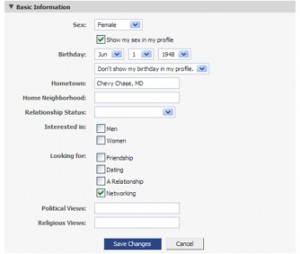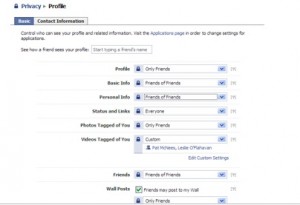-
Popular Posts
- Who Is Craig and What’s His List?
- How to Find Free Shipping E-tailers
- 5 Top Sites for Last Minute Travel Deals
- How Do Boomers and Seniors Use the Internet?
- Should You Join Facebook Now?
- Six Tips for Taking the Social Networking Plunge
- Better Bookmarking with Delicious
- Five Reasons You Can’t Afford to Dismiss Facebook and Other Social Networks
- Patient Websites Provide Bridge to Family and Friends
- About Us
Categories
site sponsors
Social Networking: The Basics
 Like many Over50s, I was skeptical about social networking. It had bad press—front-page stories of kids who lost scholarships and adults who lost jobs because of indiscreet posts. I thought I’d spend a few minutes on Facebook and MySpace, the two behemoth social networking sites, and blow them off as teenage fads like the hula hoop and pet rock. Nothing adults would use.
Like many Over50s, I was skeptical about social networking. It had bad press—front-page stories of kids who lost scholarships and adults who lost jobs because of indiscreet posts. I thought I’d spend a few minutes on Facebook and MySpace, the two behemoth social networking sites, and blow them off as teenage fads like the hula hoop and pet rock. Nothing adults would use.
But in the few minutes it took me to create my first online profile on Facebook, I discovered that this was a terrific way to stay in touch with close friends. Yes, I e-mail. I read and sometimes even send holiday letters. Those letters recap the year’s big events: hosted family reunion, reading the Great Books, vacationing in Belize. But it’s the little, but not trivial, day-to-day musings and between-the-lines news that get lost:
- Recovering from family reunion: can you recommend a day spa?
- Just finished War and Peace. Desperate for beach book!
- DO NOT do a zip line in Belize. (See photos!)
Online social networking, I discovered, is the 21st century’s kitchen table or back porch where friends gather to exchange news and gossip.
What Is Online Social Networking?
You’ve probably used your networks of colleagues, friends and friends of friends to find a job. You’ve probably also networked your way to a good doctor, a caterer, a roofer, a massage therapist, a travel companion, or a relationship.
What’s new is that online social networking broadens the scope of your network. It lets you network with anyone, anywhere, about any topic 24/7. You can network with millions of people who care about global warming or network with a half-dozen people worldwide who share your passion for saving the nearly extinct Javan rhino.
Many people think Facebook and MySpace when social networking is mentioned. But there are hundreds of other special interest social networks for business, travel, dating, reconnecting with old classmates—just about any interest or cause you can imagine. And it is now commonplace for organizations to incorporate interactive social networking tools in their websites.
At the same time, MySpace and Facebook have added dozens of applications—games, blogs, classifieds, photo and video sharing—offering all-things-web at one central location. The result is that social networking is less a specific website and more like a concept adopted and adapted by organizations for an infinite variety of uses.
Social networking is a fast-moving train, and no doubt it will evolve in unimaginable ways. But social networks are rooted in common, easy-to-use tools. So once you’re up to speed, you’re ready for wherever cyberspace takes you.
About Me: Creating Profiles
The core of social networking is your profile, a personal web page that you create by entering information in a page template (interests, education, work). Setting up a profile is easy and intuitive. You provide as much or as little information about yourself as you like. You can upload your photo—or dozens of photos—from your trip to Italy, your 60th birthday party, your granddaughter’s first birthday.
You can edit your profile at any time. You can post new content about what you are doing, reading, thinking, and planning. Every time you post something new, friends who are members of the network get a message alerting them to your new content when they log in to their personal page. Similarly, you’ll be notified on your page whenever friends comment on your post or add new content to their pages.
Friending: Any Friend of Yours. . .
You build your personal social network by friending—adding people to your private network and giving them permission to access your profile, postings, and friends.
The most obvious way to friend people is to find out if your friends already belong to the network. You can do that easily by searching by name or by letting the network search your e-mail address book to find friends already in the network. If your friends aren’t already there, you can invite them to join. Once they join and create profiles, they become part of your network.
You can also find friends by keyword searches (schools you’ve attended, places you’ve worked or lived, hobbies, or special interests). Once you’ve found your friends, you send them an invitation asking permission to friend them. When friends accept your invitation, they get added to your friends list.
You can expand your network by friending your friends’ friends. You can ask them to be a friend, or they can ask you. For kids in high school or college, having hundreds of online friends is an indication of popularity. But as Over50s know, it is the quality of friends, not the quantity, that matters.
Privacy: Friends with Privileges
You can welcome everyone into your network or you can make it a small, private club. Nobody can join your network without your permission. You choose privacy settings that dictate what you will share with your online friends. You can create categories of friends. For example, you can let all of your friends see your profile and read your posting about your Italy vacation. But only the friends you designate can see the photos of you in your bathing suit.
Customizing your privacy settings is crucial. Many users don’t bother to or don’t know they can choose who views the information they post. Unless you choose settings that limit access, almost anyone—your boss, the police, advertisers and scammers—can access your information.
Give It a Try
Social networks are quickly joining the legion of technology innovations—copiers, personal computers, cell phones and e-mail—that we didn’t need and now can’t live without. Here are some social networks to get you started.
- Build a network of business associates (LinkedIn).
- Find old friends (Classmates).
- Find true love (Match.com, Yahoo Personals).
- Find people who share your taste in movies; rate and review movies (Flixster.com).
- Create your own network for a cause or event (Ning, Webjam).
Categories: Facebook, Fun!, Safety & Privacy, Social Networking
Tags: Classmates, Facebook, Flixster, friending, LinkedIn, Match.com, MySpace, Ning, Privacy, Profiles, Social Networking, Webjam, Yahoo! Personals
Tags: Classmates, Facebook, Flixster, friending, LinkedIn, Match.com, MySpace, Ning, Privacy, Profiles, Social Networking, Webjam, Yahoo! Personals

